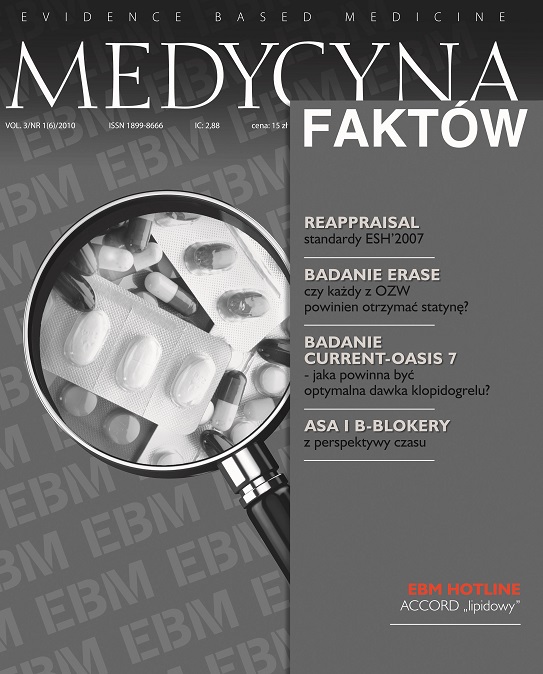Znaczenie statyn w chirurgii naczyniowej Artykuł przeglądowy
##plugins.themes.bootstrap3.article.main##
Abstrakt
Rozpowszechnienie zastosowania statyn w praktyce medycznej sprawia, że stosuje je wielu pacjentów kwalifikowanych do leczenia operacyjnego. Obserwacja tych chorych potwierdza ich korzystny wpływ na przebieg okresu okołooperacyjnego. Dzieje się tak w związku z wielokierunkowym działaniem statyn. Szczególnie korzystny wpływ stosowania tych leków obserwuje się u pacjentów poddawanych leczeniu kardiochirurgicznemu oraz operacjom naczyniowym. Badania pokazują, że leczenie statynami redukuje liczbę zdarzeń sercowych w okresie okołooperacyjnym u pacjentów poddanych np. otwartym operacjom naprawczym tętniaka aorty, rewaskularyzacjom tętnic obwodowych lub endarterektomii tętnic szyjnych. Poza działaniem hipolipemizującym statyny mają również działanie przeciwzapalne. Obniżają ryzyko uogólnionego zakażenia.
##plugins.themes.bootstrap3.article.details##
Copyright © by Medical Education. All rights reserved.
Bibliografia
2. Grabowski M., Filipiak K.J.: Simwastatyna – czy ma przewagę nad innymi statynami? Choroby Serca i Naczyń 2008; 3(supl. A): A1-A4.
3. Cieślak-Stanik D., Broncel M.: Statyny – działanie przeciwzapalne. Problemy Terapii Monitorowanej 2004; 15: 36-53.
4. Ridker P.M., Rafii N., Pfeffer M.A. et al.: Long-term Effects of Pravastatin on Plasma Concentration of C-reactive Protein. Circulation 1999; 100: 230-235.
5. Albert M.A., Danielson E., Raifai N. et al.: Effect of statin therapy on C-reactive Protein Levels. The pravastatin inflammation/CRP evaluation (PRINCE): A randomized trial and cohort study. JAMA 2001; 286: 64-70.
6. Owns J.R., Clearfild M., Tyroler H.A. et al.: AFCAPS/TEXCAPS: additional perspectives on tolerability of long-term treatment with lovastatin. Am. J. Cardiol. 2001; 87: 1074-1079.
7. Fleischer L.E., Beckman J.A., Brown K.A. et al.: ACC/AHA 2007 guidelines on perioperative cardiovascular evaluation and care for noncardiac surgery. Circulation 2007; 116: 418-500.
8. Perler B.A.: The effect of statin medications on perioperative and long-term outcomes following carotid endarterectomy or stenting. Semin. Vasc. Surg. 2007 Dec.; 20(4): 252-258.
9. Almog Y., Shefer A., Novac V. et al.: Prior statin therapy is associated with a decreased rate of severe sepsis. Circulation 2004; 110: 880-885.
10. Brookes Z.L.S., McGrown C.C., Reilly C.S.: Statins for all: the new premed? British Journal of Anaesthesia 2009; 103(1): 99-107.
11. Hacman D.G., Mamdani M., Li P., Redelmeier D.A.: Statins and sepsis in patients with cardiovascular disease: a population-based cohort analysis. Lancet 2006; 367: 413-418.
12. Maron D.J., Fazio S., Linton M.F.: Current perspectives on statins. Circulation 2000; 101: 207-213.
13. Laufs U., La Fata V., Plutzky J. et al.: Upregulation of endothelial nitric oxide syntheses by HMG-CoA reductase inhibitors. Circulation 1989; 97: 1129-1135.
14. Ross R.: Atherosclerosis: an inflammatory disease. N. Engl. J. Med. 1999; 340: 115-126.
15. Bolewski A., Plewo R., Siminiak T.: Udział czynników zapalnych w patogenezie miażdżycy. Polski Przegląd Kardiologiczny 2003; 5(1): 61-69.
16. Chojnowska-Jezierska J.: Pozalipidowe działania statyn – nowy kierunek prewencji i terapii antymiażdżycowej. Problemy Terapii Monitorowanej 2000; 11: 61-69.
17. Goldstein L.B., Amarenco P., Szarek M. et al.: Hemorrhagic stroke in the Stroke Prevention by Aggressive Reduction in Cholesterol Levels study. Neurology 2008; 70: 2364-70.
18. Scalia R., Gooszen M.E., Jones S.P. et al.: Simvastatin exerts both anti-inflammatory and cardioprotective effects in apolipoprotein E-deficient mice. Circulation 2001; 103: 2598- 2603.
19. Schwartz G.G., Olsson A.G., Ezekowitz M.D. et al.: Effects of atorvastatin on early recurrent ischeamic events in acute coronary syndromes: the MIRACL study: a randomized controlled trial. JAMA 2001; 285: 1711-1718.
20. Uzui H., Lee J.D., Shimizu H. et al.: The effect of pravastatin on the production of matrix metalloproteinase in vascular smooth cells. JACC 2001; 37: P1131-P1191.
21. Bronce M., Cieślak-Stanik D., Chojnowska-Jezierska J., Koter M.: Działanie przeciwzapalne i antyoksydacyjne simwastatyny u pacjentów z hiperlipidemią typu II. Problemy Terapii Monitorowanej 2003; 14: 176-185.
22. Sandset P., Lund H., Norseth J.: Treatment with hydroxyglutaryl-CoenzymA reductase inhibitors in hypercholesterolemia changes in the components of the extrinsic coagulation system. Arteriol. Thromb. 1991; 11: 138-145.
23. Colli S., Eligini S., Li M. et al.: Vastatins inhibit tissue factor in cultured human macrofages. Atherosc. Tromb. Vasc. Biol. 1997; 17: 265-272.
24. Rosenson R., Lowe G.: Effects of lipids and lipoproteins on thrombosis and rheology. Atherosclerosis 1998; 140: 271-280.
25. Chojnowska-Jezierska J.: Atorwastatyna – lek o najsilniejszym działaniu hipolipemicznym. Problemy Terapii Monitorowanej 2000; 11: 160-174.
26. McGirt M., Perler B., Brooke B. et al.: 3-Hydroxy-3-metylglutaryl coenzyme A reductase inhibitors reduce the risk of perioperative stroke and mortality after carotid endarterectomy. J. Vasc. Surg. 2005; 42: 829-836.
27. Amarenco P., Labreuche J., Lavallee P. et al.: Statins in stroke prevention and carotid atherosclerosis: systematic review and metaanalysis. Stroke 2004; 35: 2902-2909.
28. Martin-Ventura J.L., Blanco-Colio L.M., Gomez-Hernandez A. et al.: Intensive treatment with atorvastatin reduces inflammation in mononuclear cells and human atherosclerotic lesion in one month. Stroke 2005; 36: 1796-1800.
29. Amarenco P.: Atorvastatin in prevention of stroke and transient ischemic attack. Expert Opin. Pharmacother. 2007; 8: 2789-2797.
